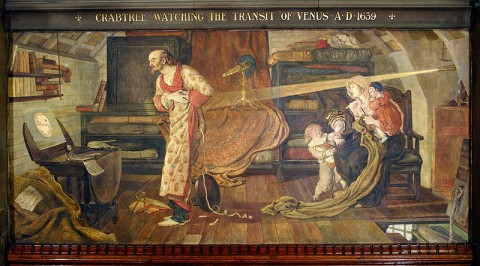Something extraordinary happens this week. The planet Venus will move across the face of the Sun for the last time in our lives.
Transits of Venus occur on a 243-year cycle, with pairs of transits eight years apart separated by gaps of 121.5 and 105.5 years. The last Venus transit happened in 2004. The next won’t occur until December of 2117. So if you want to see one, don’t put it off! “This is it, folks,” said Robert Naeye, Editor in Chief of Sky & Telescope magazine. “Unless modern medicine comes up with a miracle to extend human lifespans, this transit of Venus will be your final opportunity to watch our sister planet cross the Sun’s fiery disk as seen from Earth.”
The event will take place tomorrow, June 5, or the next day, June 6, depending on your location. In North America the transit will begin tomorrow, just after 6 p.m. Eastern Daylight Time. Because of the great distance between the Earth and Venus, the duration will be far longer than for a Solar eclipse: over six hours.
Here are six tips for making the most of this last-of-a-lifetime event:
1: Read up about it. For a quick and neatly organized overview your best bet is astronomer Chuck Bueter’s Transit Of Venus.org. The site includes all kinds of useful and interesting information, including the video above.
2: Find out when you can see it from your location. The international non-profit group Astronomers Without Borders has created an extremely handy Web page that will automatically generate a schedule of the transit for your location, based on your computer’s IP address. The site allows you to choose between a simple graphic representation (the default setting) or a more detailed data sheet. It even predicts the likelihood of cloud cover where you are.
3: Prepare for safe viewing. Looking directly into the sun can cause severe and permanent eye damage. There are a number of safe ways to view the transit of Venus, but it’s essential that you follow the advice of experts. Bueter has published an overview, “Six Ways to See the Transit.” Rick Fienberg of the American Astronomical Society has published a detailed article on how to build a “sun funnel.” And Doug Duncan, director of the University of Colorado’s Fiske Planetarium, has created a video explaining a very simple way to safely project an image of a solar event onto a two-dimensional surface using a pair of binoculars.
4: Check for events in your area. If you follow the links in step three you should be able to watch the transit on your own, but you might have more fun–and learn more–if you join a group. Astronomy clubs, planetariums and other science groups will be hosting transit-viewing events around the world. Check your local listings or go to the NASA Sun-Earth Day Web site for a comprehensive round-up of events across the globe. Just scroll the map on the NASA site over to your own geographic region and zoom in.
5: Download the app. If you have an Apple or Android device you can download a free Transit of Venus phone app that will allow you to send your own observations of the transit to a global experiment to measure the size of the Solar System. “In centuries past,” writes Steven van Roode of Astronomers Without Borders, which is organizing the project, “explorers traveled around the globe to time the transit of Venus to determine the size of the solar system. We invite you to inspire international collaboration during the 2012 transit of Venus by enabling a digital re-creation of those global expeditions. The phone app will allow citizens around the world to witness this rare phenomenon and to contribute their observation to a collective experiment to measure the sun’s distance.” Also, Sky & Telescope is helping people make the most of the transit by offering free use of its SkyWeek astronomy app through June 7. You can download it for iPhone or Android.
6: Watch the webcast. If you are unable to get a clear view of the transit from your location–or even if you are–you should check out either of a pair of live webcasts which will be held during the event. Astronomers Without Borders will transmit its webcast live from the Mount Wilson Observatory in California. The program will include interviews with experts and contributions from amateur astronomers, along with video tours of the historic observatory and its equipment, both antique and state-of-the-art. You can access the Astronomers Without Borders webcast here. Another major webcast will be broadcast by NASA from Mauna Kea, Hawaii beginning tomorrow at 9:45 p.m. UTC (Coordinated Universal Time) or 5:45 p.m. Eastern Time. You can access the NASA webcast here. For a schedule of the program, which will include many videos and interviews throughout the event, you can download a PDF.
British astronomer William Crabtree, depicted observing the 1639 transit of Venus in a mural at Manchester Town Hall, painted in 1903 by Ford Madox Brown.



Leave a Reply